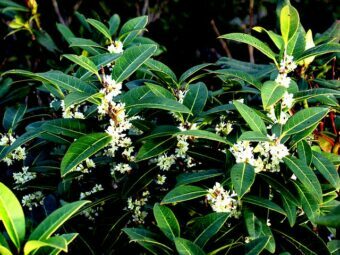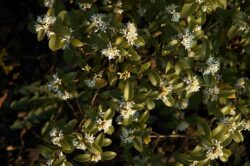In this article, we discuss how to grow Osmanthus a fragrant shrub in Containers. You will find out all about this wonderful shrub, how to care for them, how to plant them, what varieties to grow and any potential problems they will suffer from.

Osmanthus is grown for their attractive leaves but more so for their fragrant flowers that appear from early spring. They are evergreen and because of that even when not in flower they will have a point of interest. One thing that makes people take note of this shrub is that it is not commonly seen in gardens. Osmanthus has the common name of false holly because the leaves are similar to that of holly. To the untrained eye, they look very similar
The fragrant, tiny white flowers offer a great contrast to the leaves, where the plant can grow up to 4m in height. In general two species are often found in the garden- Osmanthus x burkwoodii and Osmanthus heterophyllus.
One of the biggest drawbacks of these shrubs is that the plant cannot take severe frosts, as temperatures below minus 5 degrees Celsius can kill the plant. You will not only need to protect them from frosts but also from cold Northerly or Easterly, dry winds that can also kill the plants.
This is why if cold weather is forecasted then you will need to bring the plant indoors such as a conservatory or in a greenhouse and wrap it up with horticultural fleece.
HOW TO PLANT OSMANTHUS IN CONTAINERS
If you want to plant Osmanthus in containers do so in early autumn to help the roots develop before winter arrives. This does not mean that you cannot plant in spring or summer, but you will need to make sure that the plant is well watered. Choose a big container as possible where a half-barrel is ideal.
Drill drainage holes at the bottom and line it with 5cm of gravel to help with the drainage of water. Fill this container with a mixture of 70% by volume of multipurpose compost to which 30% by volume of horticultural grit has been added.

Dig a hole twice the size of the root ball that it came in the original container and place the plant in at the same level as it came in the original container- No lower or no deeper. Backfill with growing media and add more to cover any gaps that remain, Firm it in and add water to settle the roots in. You will need to water frequently in the first year until the shrub is well established.
Make sure that the plant is in full sun although they will tolerate partial sun very well. Once established it will take drought better than most shrubs. As said earlier you need to protect the plant from cold winds and frosts or you will lose a lot of blooms.
PRUNING AND CARING FOR THIS SHRUB
You do not have to prune Osmanthus but it helps to keep it neat and tidy and will make it produce more blooms.
It is best to prune at the end of winter but definitely before the first buds appear. You can give a second prune after blooms are spent, so any spring flowers are not lost. When pruning remove any dead, crossing or damaged branches and try to open up the shrub so that air can circulate and go through the shrub.

As said previously make sure you winter protect your plant and make sure that the compost is never overly wet, as this can lead to root rot and death of the plant. This is why you will need to protect it from the cold and heavy rains.
The good news is that Osmanthus are very sturdy, do not suffer from many diseases and are not readily attacked by insects. If you are unlucky, you may get an infestation of mealybugs but you will be unfortunate if you do. Treat as soon as you observe this.
To ensure you get a good spring show, you will need to give the plant an annual dressing of slow-release fertilizer in spring. If you do, you will get more blooms and better quality of blooms.
VARIETIES TO GROW
OSMANTHUS X BURKWOODII is a shrub that has small, white blooms and elegant, colourful, glossy leaves and tends to grow faster than other species. This is why it is best to shape them with shears after flowering to give a spherical ball shape.
OSMANTHUS HETEROPHYLLUS looks like a holly bush with its large, glossy, prickly leaves but in spring it produces these wonderfully fragrant, white flowers.
Other less common varieties to grow include OSMANTHUS DELAVAYI and OSMANTHUS FRAGRANS.
CONCLUSIONS
In this article, we have discovered how to grow Osmanthus in containers, what varieties to grow, and how to get the best from them. As you see it is quite easy to look after, as long as you water right, prune the right way and fertilise in early spring. You have some choice but if you want an unusual shrub that is not often grown in the garden and that is fragrant, then this is a plant for you.
If you have any questions or comments that you wish to make on growing Osmanthus in containers or how to look after them, please do so in the comment box below.
Happy Osmanthus Growing.

What size pot would be best for a 9cm Osmanthus? Is 50cm far too big to begin with?
Thank you
Hi Alison
As shrubs tend to grow quickly I would strat with a 30cm diameter pot and pot up as it gets root bound.
Thanks
Antonio